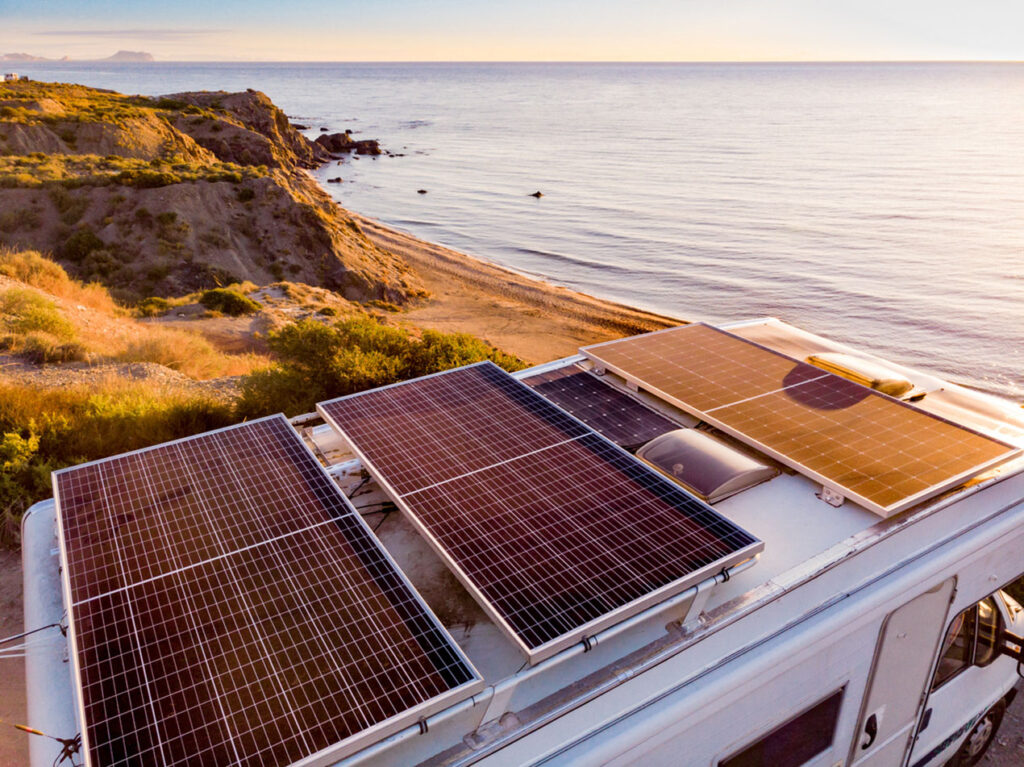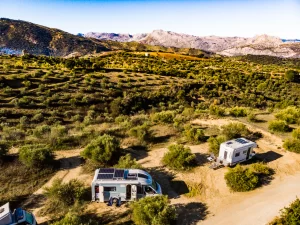Recreational vehicles (RVs) are synonymous with freedom, adventure, and mobility.
However, to ensure all the comforts of home are available, a well-functioning electrical system is crucial.
Here we explore the basics of RV electrics, covering power sources, main components, voltage differences, power consumption by devices, safety considerations, differences in RV class, and common modifications to interior circuits.
How are RV Electrical Systems Powered?

RV electrical systems are designed to be versatile, catering to the needs of travelers both in remote locations and in established campgrounds. The primary sources of power for RV electrical systems include:
Shore Power: This refers to connecting your RV to an external electrical supply available at campgrounds or RV parks. Shore power can provide a continuous electricity supply, allowing the use of high-power consumption devices without draining the RV’s batteries.
Generators: For off-grid camping or in the absence of shore power, generators are a popular option. They convert fuel (gasoline, diesel, or propane) into electrical power, providing flexibility and autonomy.

Batteries: RV batteries store electricity for use when neither shore power nor generators are available. They are essential for powering 12-volt systems and appliances within the RV. Batteries can be daisy-chained (positive to positive, and negative to negative, between battery terminals) to provide additional storage while preserving the 12v supply.
Solar Panels: Solar panels convert sunlight into electricity, charging the RV’s batteries. This sustainable option is ideal for long-term camping in remote locations. Most can provide a split charge, with one circuit charging your batteries, while the other provides power for cabin lights, or even a fridge.
Wind and Water Power: Also worth considering are recent innovations in portable wind and water turbines. These use the natural resources of wind or a rushing stream to convert kinetic energy (movement) to electrical power.
What are the main components of an RV electrical system?
An RV electrical system consists of several key components:
Batteries: Serve as the heart of the system, storing power for use when other sources are unavailable.
Inverter: Converts 12V DC power from the batteries into 120V AC power, enabling the use of standard household appliances. Read our Ultimate Introduction to Inverters post.
Converter: Performs the opposite function of the inverter, converting 120V AC power into 12V DC power to charge the batteries and power 12V systems.
Transfer Switch: Automatically switches between power sources (shore power, generator, batteries) without manual intervention, ensuring a continuous power supply.
Circuit Breakers and Fuses: Protect the electrical system from overload and short circuits, ensuring safety.
What is the difference between 120V and 12V power sources?
An RV electrical system utilizes both 120V AC and 12V DC power sources.
120V AC power, like that in domestic homes, is used for high power consumption appliances like air conditioners, microwaves, and refrigerators when connected to shore power or running a generator.
On the other hand, 12V DC power is used for lighting, water pumps, fans, and other low-power devices, primarily running off the RV’s batteries. The versatility in power options ensures that all electrical needs are met, regardless of the location.
What devices draw power in an RV?
Devices that draw power in an RV can be categorized based on their power requirements:
High-Power Devices: Air conditioners, heaters, microwaves, and electric kettles, which usually require a 120V AC power source.
Low-Power Devices: Lighting, water pumps, fans, and USB charging ports for electronic devices, typically powered by 12V DC.
High power devices typically can’t be used when you are on battery power only, unless you use an inverter, in which case apply caution: such devices drain batteries rapidly.
Understanding the power requirements of each device is crucial for efficient energy management, especially when off-grid.
What safety considerations are there in RV electrical circuits?
Safety in RV electrical systems is paramount. Key considerations include:
- Regular Inspections: Ensuring all connections are secure and free from damage.
- Proper Use of Circuit Breakers and Fuses: To prevent overload and potential fires.
- Awareness of Power Limits: Avoiding the simultaneous use of high-power devices to prevent system overload.
- Carbon Monoxide Detectors and Fire Extinguishers: Essential for detecting issues from generators and dealing with electrical fires.
Are there important electrical differences between RV classes A, B, and C?
Class A, B, and C RVs cater to different lifestyles and preferences, leading to distinct needs and electrical setups in each. Here’s an overview of these differences:
Class A RVs: Luxury on Wheels
Class A RV interiors are the largest and most luxurious available, often equipped with amenities that rival homes. They’re built on a specially designed motorhome chassis.
Electrical Needs:
- Higher Power Requirements: Due to their size and the range of amenities they offer (multiple air conditioners, residential-style refrigerators, entertainment systems), Class A RVs have higher power needs. They often require 50-amp shore power connections to accommodate their electrical load.
- More Complex Systems: The electrical system in a Class A RV is more complex, including larger battery banks, inverter systems capable of handling more appliances, and sophisticated monitoring systems to manage energy consumption efficiently.
The drawback is that such vehicles are harder to use off-grid for extended trips, since so many of their appliances require a higher voltage than batteries can readily supply.
Class B RVs: Compact and Efficient
Class B RVs, or camper vans, are the smallest and are built on a van chassis. They are known for their efficient use of space and are ideal for solo travelers or couples.
Electrical Needs:
- Lower Power Requirements: With fewer amenities than Class A or C RVs, Class B’s electrical systems are designed for efficiency and minimalism. They typically have smaller battery banks and may use less power, often needing only a 30-amp or even a 20-amp shore power connection.
- Solar and Battery Upgrades: Owners often prioritize upgrades like solar panels and high-capacity lithium batteries to maximize independence from shore power, given the vehicle’s smaller size and more limited storage space for generators.
Class C RVs: The Middle Ground
Class C RVs strike a balance between A and B, offering more space and amenities than Class B but in a more compact footprint than Class A. They are built on a truck chassis and often feature an over-cab sleeping or storage area.
Electrical Needs:
- Moderate Power Requirements: Their electrical systems are like Class A RVs but on a slightly smaller scale. They can typically operate on 30-amp shore power, though some larger Class C RVs require 50-amp connections for higher-demand appliances.
- Versatile Systems: Electrical setups in Class C RVs aim to provide a good balance between on-grid and off-grid capabilities. This often includes larger battery banks, inverter systems, and solar panels to extend off-grid camping capabilities.
General Considerations Across Classes:
Adaptability for Off-Grid Use: Across all classes, there’s a growing interest in off-grid capabilities and sustainability. Solar power, along with efficient use of generators and upgraded battery storage, is increasingly common.
Energy Management Systems: More sophisticated RVs might include energy management systems that automatically adjust energy consumption based on available resources, ensuring critical systems remain powered, and warning the user when batteries run low.
Customization and Upgrades: Owners often customize their RVs to suit personal needs, such as adding extra solar panels, upgrading to superior lithium batteries, or integrating smart systems for monitoring and control.
Regular Maintenance and Repair: It’s important to visit an experienced RV repair shop, to ensure your electrical systems are in good shape, since wear and tear and vibrations during travel can dislodge or damage components.
Owners tailor their systems based on travel habits, from full-time living and frequent off-grid camping to occasional use, mostly staying in fully serviced RV parks.
What modifications can be made to RV interior circuits?
RV owners often modify their interior circuits to enhance functionality and comfort. Common modifications include:
- Upgrading Batteries: Installing high-capacity or lithium batteries for extended off-grid capabilities.
- Adding Solar Panels: To reduce reliance on generators and shore power, and for an environmentally friendly power source.
- Installing Additional Outlets: For greater convenience and to accommodate more devices.
- Upgrading Lighting to LED: LED Lighting reduces power consumption and heat generation.
Understanding the basics of RV electrical systems is crucial for any RV owner or enthusiast. By grasping how these systems are powered, their components, the differences between power sources, and the necessary safety considerations, RVers can ensure a safe, comfortable, and enjoyable travel experience.
With the right knowledge and precautions, the electrical system of an RV can boost rather than bamboozle, enabling extended trips and making possible the #vanlife lifestyle.






